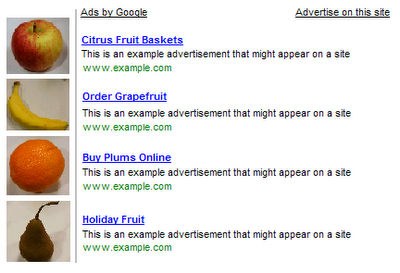Google announced the launch of extensive changes to their ad formats last week. Interestingly, some are like the methods AdSense publishers used to use to increase CTRs before Google banned them.
The official Google Blog details many of these changes, from extra links to more specific content, such as types of bookings available for travel and images and prices of product searches.
Without a doubt, these new methods will help generate higher CTRs and thus gain Google more income. Given the decrease in overall advertising right now, this method will help offset some of that lost ad revenue by increasing the amount they get from their existing advertisers.
A few years ago, some creative AdSense publishers used to place pictures in front of the ads to help increase CTRs, but this become against the Google AdSense terms and conditions. The ad and image placement policy stated:
"We ask that publishers not line up images and ads in a way that suggests a relationship between the images and the ads. If your visitors believe that the images and the ads are directly associated, or that the advertiser is offering the exact item found in the neighboring image, they may click the ad expecting to find something that isn't actually being offered. That's not a good experience for users or advertisers.
Publishers should also be careful to avoid similar implementations that people could find misleading. For instance, if your site contains a directory of Flash games, you should not format the ads to mimic the game descriptions." So images like the one below were banned:

But now Google has started using these methods themselves. True, the images are from the advertiser/product seller and generally are directly appropriate, but it's interesting that the methodology was tested for them by publishers and was known to increase CTRs.
These new ad formats mark an aggressive move by Google to increase CTRs. Google is also in the process of buying display advertising optimization company Teracent, which will also help increase appropriate ad displays.
Google seems to be spending a lot of time improving their advertising products -- a smart move before the busiest shopping period of the year. And thankfully, they haven't changed the algorithm, as has occurred in the past when people scurried to buy more ads to make up for the unexpected loss of organic traffic.
Chris Boggs Fires Back
Frank, this is keen insight and certainly proof that designers of calls to action should still strongly consider images to be a key part of the puzzle. From an SEO perspective, this further reinforces the idea that having relevant non-HTML content that can be closely identified to the HTML content can be helpful as well.
Universal search drove many experiments in the area of optimizing video and image content. A page could be considered more credible on a topic if it includes more than just text, but images or videos associated with the content -- and verified by links which reference "picture" or "video."
Google likely has lots of data supporting this move from its own SERPs. In 2007, Gord Hotchkiss and Enquiro provided a brave look into the future of search when they developed the white paper "Search Engine Results: 2010." In it, they discussed early eye tracking studies of universal search results showed a prominent bias toward an image showing up in the results page. It would be interesting to see an update of this now nearly three years later, to see if searchers have become more accustomed to images and other universal results, and started to revert back to the original "F" shaped pattern that made the first Enquiro heat map so memorable.
Marketers in all industries will need to continue watching for sites poaching traffic from them and serving AdSense ads, and perhaps consider more images and other content on their pages to stay ahead of the pack. Optimizing the image attributes, and even file names and locations, continues to be an important factor to address given the time and resources to make the necessary changes.
Meet Frank Watson and Chris Boggs at SES Chicago on December 7-11, 2009. Now in its 11th year, the only major Search Marketing Conference and Expo in the Midwest will be packed with 70+ sessions covering PPC management, keyword research, Search Engine Optimization (SEO), social media, local, mobile, link building, duplicate content, video optimization and usability, while offering high-level strategy, keynotes, an exhibit floor, networking events and more.
» Print this article » E-mail a colleague » Post a comment » Share 


Biography
Frank Watson has been involved with the Web since it started. For the past five years, he headed SEM for FXCM -- at one time one of the top 25 spenders with AdWords. He has worked with most of the major analytics companies and pioneered the ability to tie online marketing with offline conversion.
He has now started his own marketing agency, Kangamurra Media. This new venture will keep him busy when he is not editing the Search Engine Watch forums, blogging at a number of authoritative sites, and developing some interesting online community sites.
He was one of the first 100 AdWords Professionals, a Yahoo and Overture Ambassador, and a member or mod of many of the industry forums. He is also on the Click Quality Council and has worked hard to diminish click fraud.
Article Archives by Frank Watson:
It's Beginning to Look a lot Like Christmas: Changes At Google to Increase Ad Spends - December 4, 2009
Philosophy and Search: The Big Three Founders and the Philosophers - October 30, 2009
Team Work Has More Rewards Than a Group Effort - October 16, 2009
There Are No Search Rock Stars - October 2, 2009
Internet Marketing is Like Talking to Children - September 4, 2009
Is Google the Lazy Man's Marketing Method? - August 21, 2009
» More Articles by Frank Watson


No comments:
Post a Comment